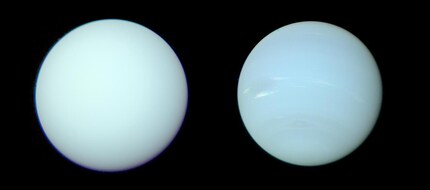
Neptune's blue is an illusion
The icy planet Neptune is known for its deep blue colour. However, the planet actually looks completely different - it was simply a victim of image processing.
Far out on the edge of the solar system, two blue planets are orbiting: the ice giants Uranus and Neptune. While Uranus, which is closer to the sun, is known for its turquoise colour, Neptune shines a deep navy blue in images. But the difference in colour between the two is an illusion, a research group led by planetary scientist Patrick Irwin from the University of Oxford has now discovered. As the team reports in the journal "Monthly Notices of the Royal Astronomical Society", the different colours of the two planets are merely the result of subsequent image processing. In fact, both planets have almost the same colour: the soft green-blue that was previously only associated with Uranus.
The misperception has a technical background. The images that were taken of the two planets in the 1980s - in particular with the Voyager 2 space probe, which was the only one to photograph both planets up close - were taken through different colour filters. This means that each image only shows a narrow wavelength range. In order to reproduce the "true" colour of the planets in all wavelengths, several such images have to be combined. To do this, the individual images must be carefully weighted, and this was often not the case, as the experts report. In the case of Neptune in particular, the blue wavelength ranges were overemphasised.
In addition, in the early Neptune images taken by Voyager 2, the contrast of the images was greatly enhanced in order to better visualise clouds and wind bands. This also made the blue colour of the planet appear deeper - which was also known when the images were published. This subtlety only came to light later, explains Irwin in a press release from the university.

Source: © Patrick Irwin (Ausschnitt)
In order to eliminate such difficulties and find out the true colour of the two planets, his team did not use a normal camera, but data from spectrographs of the Hubble telescope and the Very Large Telescope of the European Southern Observatory. Such instruments register the entire spectrum of visible light in each image pixel. They are normally used to measure absorption and emission lines of various elements and molecules; however, as the data contain all colours simultaneously, they also reflect the true colour of an object. Using this information, the research group has now combined the single-colour camera images of the planets in the correct weighting - and discovered that Neptune is much less blue than it previously appeared.
The team also solved a long-standing mystery about Uranus thanks to the precise colour data. It is sometimes a little greener and at other times a little bluer. They knew that this had to do with the planet's axis of rotation. Uranus lies on its side, so that every 42 years, after half of the orbital period, one pole points exactly towards the sun and 21 years later the equator. The poles are clearly greener - but it was not yet clear why. Comparisons of the colour spectra obtained by the team now provide the answer. The data show that a fog of methane ice forms at the poles in summer, which reflects more green light.
Spectrum of Science
We are partners of Spektrum der Wissenschaft and want to make well-founded information more accessible to you. Follow Spektrum der Wissenschaft if you like the articles.
[[small:]]
Cover image: © NASA (detail) False colour image: This is how Uranus (left) and Neptune (right) are known - images taken by Voyager 2 in 1986 and 1989. In reality, however, the colours are not correct.Experts from science and research report on the latest findings in their fields – competent, authentic and comprehensible.